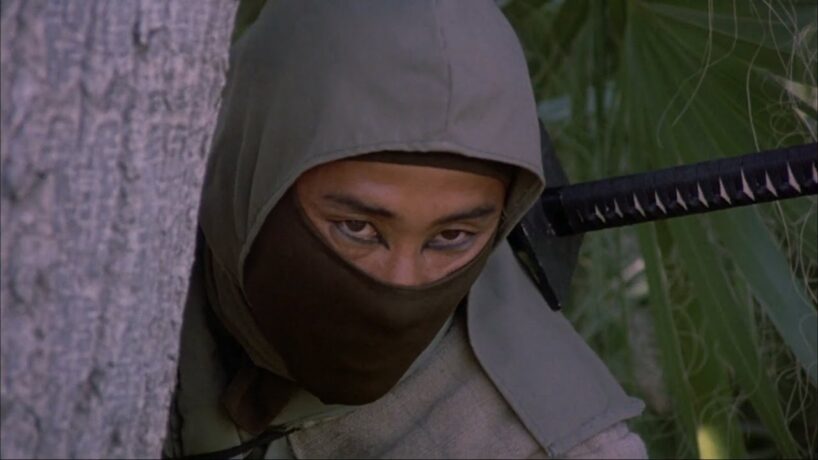The Ninja: America’s Sinister New Hero
Galloping out of the west rode the masked man whose real identity was never known, the Lone Ranger. Then came the being with supernatural powers, Superman. Next came the superspy of superspies, James Bond. And, most recently, there was the martial arts virtuoso, Bruce Lee. Now the mystery, superhuman powers, espionage skills, and martial arts of these past American heroes come to the screen embodied in a single human form: He’s America’s sinister new hero, the ninja.
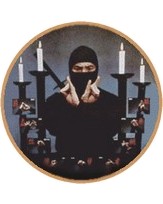 Of course, there are still some people who haven’t even heard of him yet, but given the current growth rate that the ninja phenomenon is experiencing, it won’t be long before the ninja becomes the topic of conversation at morning coffee klatches and cocktail parties. This might be the final affirmation that the mysterious, almost mythical character has become fully incorporated into mainstream Americana and is indeed the latest fad to sweep the U.S.
Of course, there are still some people who haven’t even heard of him yet, but given the current growth rate that the ninja phenomenon is experiencing, it won’t be long before the ninja becomes the topic of conversation at morning coffee klatches and cocktail parties. This might be the final affirmation that the mysterious, almost mythical character has become fully incorporated into mainstream Americana and is indeed the latest fad to sweep the U.S.
For those of you who aren’t familiar with the ninja or falsely believe that he exists only in Japanese chanbara movies, you skeptics who doubt that the ninja is alive and well and living in America, just consider The Octagon, Shogun, Shogun Assassin, Enter the Ninja, The Ninja, Revenge of the Ninja and Shinobi. These are films that Western audiences have either already seen or soon will see in their neighborhood theaters in the months to come. All of these movies have scenes of, or are entirely based on, the ninja and ninjutsu, “the art of invisibility”, “the art of stealth”.
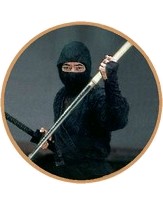 What is it then about the arcane ninja that has caught the imagination of Hollywood’s filmmakers and, subsequently, American filmgoers? Was ninja-mania sparked by a single vehicle such as Eric Von Lustbader’s best-selling novel, The Ninja, or were there a number of causative factors that led to his popularity? As difficult as it is to second-guess public opinion, it is often more perplexing to trace the various sociological, economic and psychological conditions which lead to the making of the average, everyday “craze”. The opinions that follow may provide some insight for readers who are curious about what some call America’s greatest hero, and others consider America’s greatest sin.
What is it then about the arcane ninja that has caught the imagination of Hollywood’s filmmakers and, subsequently, American filmgoers? Was ninja-mania sparked by a single vehicle such as Eric Von Lustbader’s best-selling novel, The Ninja, or were there a number of causative factors that led to his popularity? As difficult as it is to second-guess public opinion, it is often more perplexing to trace the various sociological, economic and psychological conditions which lead to the making of the average, everyday “craze”. The opinions that follow may provide some insight for readers who are curious about what some call America’s greatest hero, and others consider America’s greatest sin.
As far back as the April 1980 issue of Inside Kung-Fu magazine, John Corcoran hailed the ninja phenomenon as America’s next movie trend in an article entitled “The Ninja: Hollywood’s Newest Hero”. Here he stated, “The ninja’s arsenal of secret weapons, his techniques of astonishing camouflage, and seemingly magical powers of infiltration make him an ideal screen character of infinite dimensions. A more perfect fantasy character would be hard to find.”
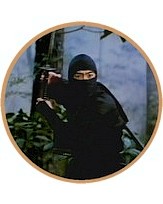 Since magazines require months of preparation before they hit newsstands, Corcoran had actually made his prediction while compiling the story in December 1979, long before the vast appeal of this mysterious art had come to the attention of movie moguls and the general public. When queried about which roads he traveled to arrive at his deduction, Corcoran commented, “Phenomena tend to run in seven year cycles; this is particularly true in the film industry, so I had anticipated a return in popularity of the martial arts films. Then when the re-release of Bruce Lee’s Enter the Dragon outgrossed Kramer vs Kramer in New York in May 1980, that was further indication that martial arts genre films would once again do well at the box-office.”
Since magazines require months of preparation before they hit newsstands, Corcoran had actually made his prediction while compiling the story in December 1979, long before the vast appeal of this mysterious art had come to the attention of movie moguls and the general public. When queried about which roads he traveled to arrive at his deduction, Corcoran commented, “Phenomena tend to run in seven year cycles; this is particularly true in the film industry, so I had anticipated a return in popularity of the martial arts films. Then when the re-release of Bruce Lee’s Enter the Dragon outgrossed Kramer vs Kramer in New York in May 1980, that was further indication that martial arts genre films would once again do well at the box-office.”
“However, it was clear that any resurgence would not have Bruce Lee and they would have to have a new formula. They couldn’t use the same format of previous films because they tried that after Bruce Lee and they invariably flopped. So, there was no doubt in my mind that there had to be a new element, something that the public at large had never been exposed to before. The mystery of the ninja, coupled with his superior fighting skills, seemed to be a natural for films.”
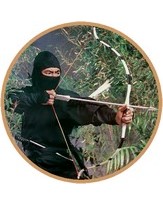 “The capper, of course, was when The Ninja hit the New York Times best seller list after six weeks of it’s initial release, then stayed there for five full months. To me, that was the final confirmation that American’s were ready for this type of concept in the martial arts, and the movie industry would quickly pick up on this.”
“The capper, of course, was when The Ninja hit the New York Times best seller list after six weeks of it’s initial release, then stayed there for five full months. To me, that was the final confirmation that American’s were ready for this type of concept in the martial arts, and the movie industry would quickly pick up on this.”
Of course, readers who saw the ads for The Ninja know that Richard Zanuck and David Brown of the Zanuck-Brown production team (The Sting, Jaws, The Island) heartily agree. The ad copy included a Zanuck-Brown statement which enthused, “We can’t wait to get The Ninja in front of the cameras.” Although they are loath to classify The Ninja as strictly a martial arts film for fear they might limit their market, Zanuck says. “There won’t be any shortage of action scenes.” The team’s enthusiasm about Von Lustbader’s novel that Zanuck describes as “quite simply one of the best things I’ve ever read” led to Twentieth Century Fox’s stamp of approval to the tune of a reputed $20,000,000 production budget. [Note: This film was never made.]
Just as several scientists, working independently, can simultaneously arrive at the same scientific breakthrough, so it appears that several filmmakers concurrently converged on the ninja phenomenon as the next subject for American film fare. Although The Ninja may have been the first movie to be slated for production, Enter the Ninja by Cannon films will be the first film focussing exclusively on ninjutsu to actually reach American audiences. Pricilla McDonald, public relations director and spokesperson for Cannon, explains her instrumental role in Cannon’s decision to produce Enter.
“Mike Stone brought me a script called Dance of Death. Until then, I had never heard of ninja or ninjutsu. But after reading the script, I became so excited about it that that’s all I would talk about with the president of Cannon, Menahem Golan. We had never done a martial arts film before so he was a bit wary and didn’t want to hear about it. But the whole concept of ninjutsu fascinated me: the mysterious qualities about it, the fact that it had never been done before in the West. It just had a lot of overpowering interesting qualities that were very cinematic – the swords, all the weapons, costumes, the frightening element of the ninja and the action sequences. Well, I just kept blabbering to Mr. Golan, so he finally said, ‘Oh, all right, bring him in.’ Then once he’d talked to Stone, he became so involved that he ended up directing it himself.”
So convinced is Cannon of the ninja’s appeal that the press release for Enter the Ninja states, “…Ninjutsu. It will set the trend in martial arts films for the ’80s, making them the decade of the Ninja, as Kung Fu was for the ’70s, Karate for the ’60s, and Judo for the ’50s.”
There can be no doubt that American Cinema’s The Octagon, with it’s formidable ninja training fortress, and NBC-TV’s Shogun, which incorporated several ninja incidents, also paved the way for heartland America’s acceptance of an art which, with its cloak of mysticism and aura of the occult, goes one step beyond most people’s concept of the martial arts. But even predating this exposure, the art of ninjutsu was featured in the early 1970s on the once-popular Kung Fu television series, when Robert Ito (Sam in Quincy) played a crippled servant throughout three-quarters of the episode, only to surprise audiences by suddenly dropping his disguise and transforming into a dangerous, shuriken-throwing death machine doing battle against the inscrutable Caine. Delving back even further into the dusty archives, ninja first appeared on the international large screen in the 1967 James Bond thriller You Only Live Twice when 007 joined forces with a band of Japanese ninja agents to overthrow a villain of super-evil magnitude. Incidentally, Sho Kosugi (the black ninja in Enter the Ninja) says that the ninja scenes in the Bond escapade were especially memorable to residents of Osaka, Japan. It seems that in their fervor for authenticity, the Bond ninja left behind shuriken holes in the sacred, but wooden walls of Osaka castle.
Aside from the film industry’s obvious convictions regarding the commercial appeal of the ninja and the dollar profits to be made, there must be other underlying factors which account for the average man’s acceptance of this obscure, certainly controversial character. Stephen K. Hayes, the first recognized American ninja of the Togakure ryu school of ninjutsu, has probably spent more time and effort than any other American exploring the innermost workings of this martial art. Back in 1975 when Hayes first became enchanted by the ninja lifestyle and philosophy, many of his associates found his interest in this unknown art totally incomprehensible. Now the tide has turned and ninjutsu has become the “in” art, to the extent that many non-ninja are slapping hastily made stickers advertising “Ninjutsu taught here” on their dojo windows to entice the unsuspecting. When asked for his observations on what accounts for the rising notoriety of the ninja, Hayes responded, “I think it was probably a combination of things. In the entertainment industry, I think people were looking for something new. Also, there was a growing feeling in the U.S., where people are a little more open to new ways of doing things, of acceptance of the supernatural, so the mysterious element of the ninja, its association with the occult and so forth may have played a part in it. A third element might just be timing. People are in a phase right now where there’s an acceptance of the romantic warrior. And, of course, the ninja would be the real epitome of that idea, a single person taking on whole armies. We saw this romantic warrior syndrome in Shogun, The Ninja and even to some extent in Star Wars.”
“It could simply be a reaction against what’s going on in everyday society and the economy. People are scared. They’re fed up, they don’t know where to turn. A lot of things they used to believe in aren’t working out. So this concept of the romantic warrior is exciting to people. We can also see that in the popularity of the soldier of fortune, mercenary type magazines that are springing up, and are suddenly becoming very socially acceptable. Perhaps it’s just the opposite of the ’60s when it was very unfashionable to be associated with anything militaristic; maybe people are saying, ‘Well that didn’t work. Maybe we should take a stand on something else.’ “
Hayes’ words ring prophetically, echoing many Americans’ concern over personal safety and search for some means of gaining control over their lives. Other manifestations of this fear can be recognized in the sudden burgeoning of mace classes, the rise in gun sales, and overflowing dojos, further stimulated by the attempted assassinations of President Reagan and the Pope, and the death of John Lennon. The ever-growing interest and acceptance of parapsychology, and the religious awakening of such celebrities as Cheryl Ladd, Barbra Streisand and Elliot Gould would suggest that even those who are financially secure are seeking security of an emotional nature, believing that the answer lies somewhere beyond the range of man’s cognitive powers; perhaps, as Hayes alluded, somewhere in the occult.
If some Americans do find practical solutions to their dilemma in the ninja concept, the question automatically arises, what will be the societal ramifications of a large mass of people converting to this brand of “faith”? If some do indeed consider the ninja America’s latest hero, will this trend sprout a vigilante mentality in its minions, creating a generation of pseudo-sorcerers who concoct magic potions to eliminate anyone who looks cross-eyed at them? Or consider an even more extreme possibility: we would become even further fractionalized, a nation of hunters versus the hunted.
The answer, of course, lies partially in each individual’s discriminatory capacities, and largely in how the media portrays the ninja. Filmically to date, the ninja have invariably been merciless, conscienceless assassins – spies, masters of disguise, martial magicians of weaponry, concoctors of potent death potions, demi-gods who transform themselves at will into rocks or birds, levitators who walk on water – all masked by the foggy aura of mystery. Whether one believes this image or relegates it to the realm of folklore and partial fantasy as Hayes does, is almost irrelevant. The deciding factor will be how the media portrays them in the future.
In a departure from film tradition, Enter the Ninja, The Ninja, Revenge of the Ninja and Shinobi, dilute the sinister image presented in the usual spate of “bad” ninja, by also including some “good” ninja who fight on the proverbial “side of justice”. Although this characterization of ninja as heroes instead of villains may seem contradictory, as Sho Kosugi explains, it’s all a matter of perspective. “It’s very hard to call ninja either good or bad. If they acted as spies for your side, they were considered good. But if they were on the enemy side, they were considered bad.”
As can be expected, the casting of the key hero role is crucial in determining the impact of the new “good” ninja image. Filmmakers are looking for a hero who not only fits the American image of a good guy who incidentally displays superior martial arts skills, but one who also reflects a touch of cold-bloodedness without appearing totally heartless. In the case of Franco Nero, who portrayed the white ninja in Enter the Ninja, one would surmise that he was selected not only because of his physical characteristics and versatile acting abilities (Camelot, The Bible, Force 10 From Navarone, Salamander), but also because in spaghetti Westerns in the Clint Eastwood tradition, he exhibited the ability to kill almost casually, while still convincing the audience that somehow, this man is not evil.
In Cannon’s next film, Revenge of the Ninja, Sho Kosugi switches roles from black to white, assisted by his sidekick, karate champion Keith Vitali. Vitali, no doubt was selected not only because of his martial arts expertise but also because of his clean good looks which are sure to win the hearts of many potential ninja fans.
To date, Zanuck-Brown has not cast the starring role of Nicholas Linnear, the half-Caucasian, half-Oriental hero in The Ninja, but there can be no doubt that they will pick a unique individual to match the epic proportions of the largest budget martial arts film ever produced. According to a spokesperson for Joyce Robinson & Associates, who will handle the actual screening of Nicholas hopefuls, the man selected to play what may become known as the ultimate martial arts roll of all time will be “someone who knows his own mind; he keeps his own counsel pretty much. There’s a kind of quiet strength about him, an assurance without being cocky. A leading man who’s got a lot of charisma.”
Tadashi Yamashita, Eric Lee and Karen Lee Sheperd portray the heroic ninja in Shinobi. Perhaps no casting could better transform the image of the ninja than this trio of skilled martial artists. Each of them has already garnered many fans across the country from their respective dazzling weapons and kata demonstrations, fans who know them not as ruthless killers, but as highly polished performers.
Of course the final responsibility for the ninja image and its subsequent effects lies with the directors and editors. However, with highly skilled actor-martial artists such as the above, and with the portrayal of charismatic ninja such as Nicholas, in The Ninja, one suspects that the dark side of the ninja force will be negated by the positive aspects of the art of ninjutsu. As Hayes points out, “There are two main things that one can get from ninjutsu – a return to realism and a return to the power of the working mind.”
The true reasons for America’s growing fascination with the character will probably remain hidden in the dark mists where the erstwhile spies and assassins are in their element. Yet the current trend in portraying ninja in a positive light allows one to be hopeful. Perhaps the ninja is not merely another symptom of American anxiety, but, by converting a malignant villain into a new image of the hero, portends a triumph of idealism over cynicism.
The Ninja: America’s Sinister New Hero by Lucille Tajiri
(Published in the August 1981 issue of MARTIAL ARTS MOVIES magazine.)
